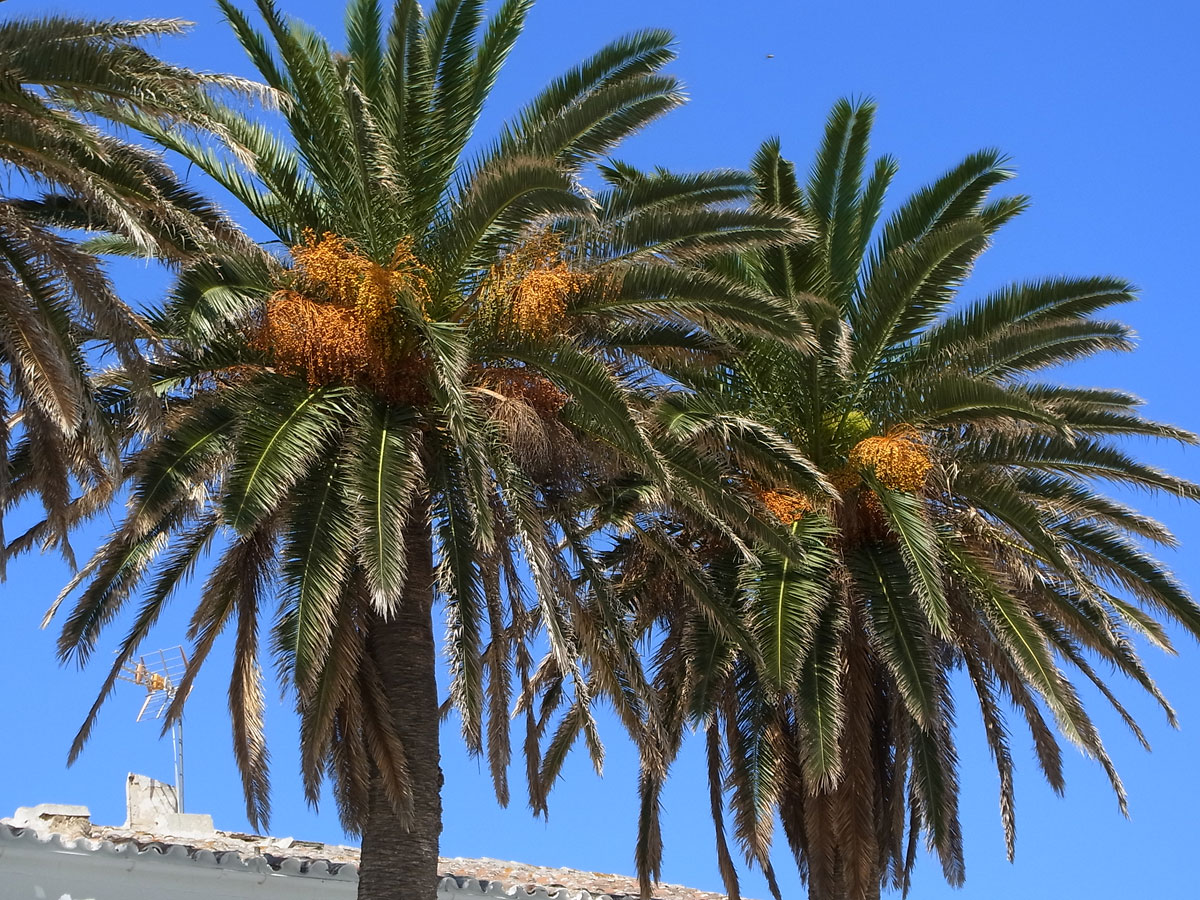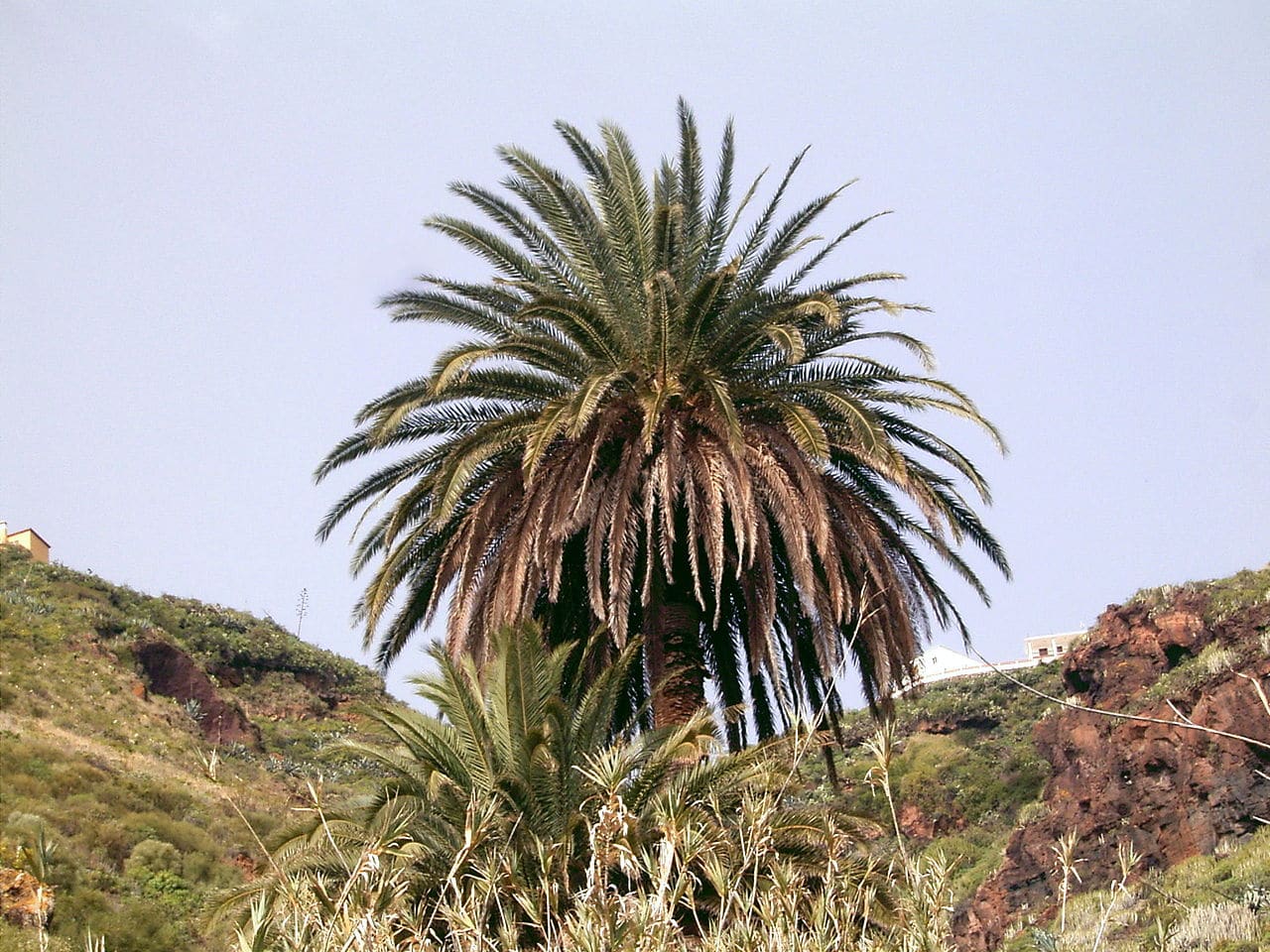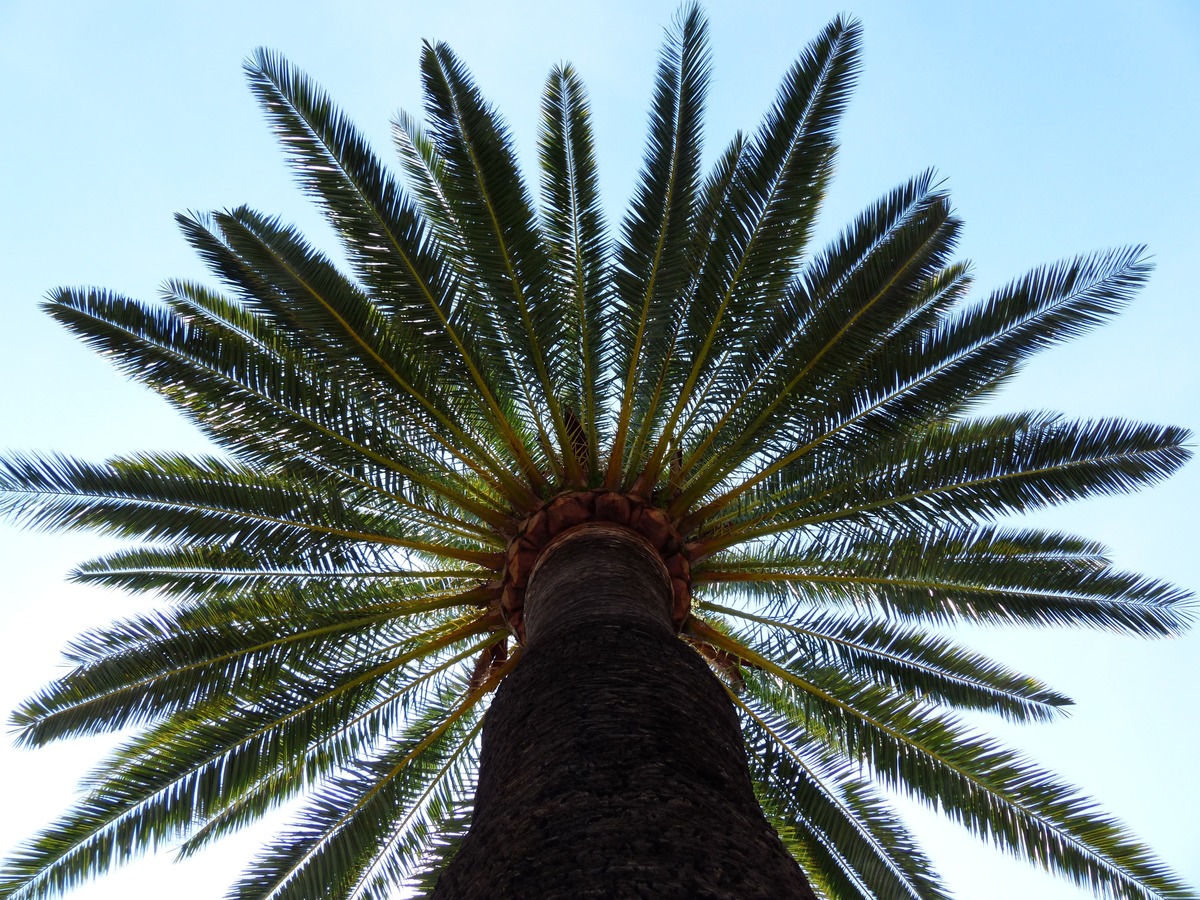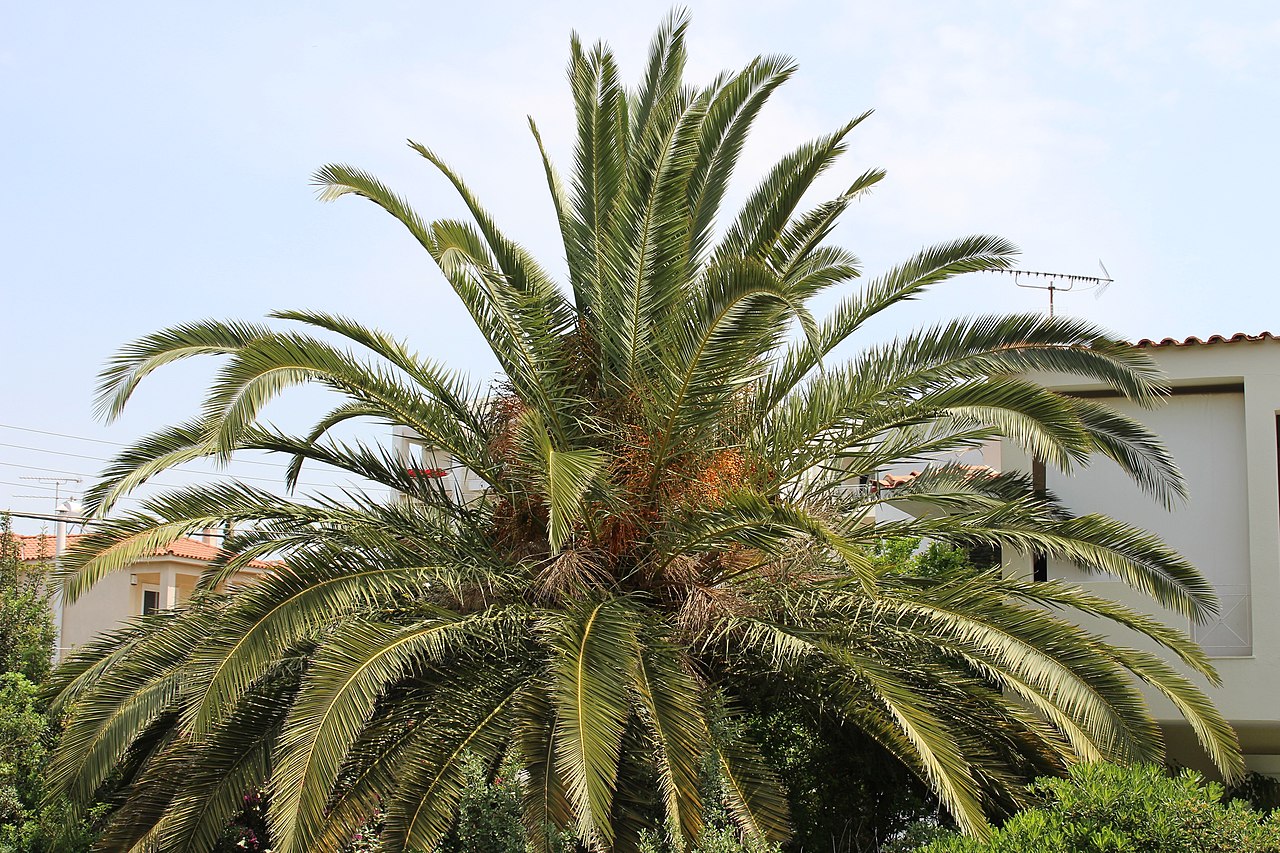
Image - Wikimedia / Donkey shot
Our protagonist is one of the plants that is most often included in urban design. It is very common to find a specimen in roundabouts, parks, and of course in Botanical Gardens. It is known by multiple names, although one of the most used is that of canary palm tree.
This is a plant that we can see frequently in parks and gardens in temperate and tropical regions around the world, as it is not only highly adaptable, but also has a very high ornamental value.
Origin and characteristics of the Canarian palm tree

Image - Wikimedia / Frank Vincentz
The Canary Island Palm, whose scientific name is Phoenix canariensis, is native to the Canary Islands. It is also known by the names of phoenix, támara, or palm of the Canary Islands. It is a species that can grow up to 13 meters in height, with a trunk thickness of up to 1 meter. Its leaves are pinnate, with a length of about 5 to 7 meters, and are dark green.
Blooms in spring, producing inflorescences (groups of flowers) branched between the leaves, yellow-orange. The fruits are ovoid, 2-3 centimeters long, and orange-yellowish. These contain a 1-2 centimeter seed, ribbed, and light brown in color.
Unlike the date palm (Phoenix dactylifera), it is unicaule, which means that it only has a single trunk. It is very resistant to cold, being able to withstand temperatures of 5 even 7 degrees below zero; Furthermore, it also likes heat, since even if the thermometer rises above 30ºC it continues to grow.
This exceptional plant has a rather fast growth, but without being excessive. During the vegetative season -which is when the palm tree is growing-, depending on the growing conditions it will grow between 20 and 40cm.
How to take care of it?

Location
Now Phoenix canariensis it must be planted in a location exposed to the sun directly, since otherwise it would produce increasingly decayed and long leaves, with broader than normal leaflets.
Irrigation
It is important, especially during the summer, water sparingly, for example 3 or 4 times a week. In the rest of the stations, between 1 and 2 weekly irrigations will be sufficient.
In any case, this will vary depending on the climate, that is, in those that are hotter and drier, the frequency of irrigation will be higher than in that of the more temperate and / or humid climates.
Subscriber
It is a palm tree to which it is recommended to pay biweekly during the spring and summer months. To do this, you can apply specific fertilizers for these palm trees, or opt for other organic ones, such as compost or herbivorous animal manure.
Planting or transplanting time
During the spring, as soon as the frosts have passed. It is a plant that, although it may be in a pot during its first years, there will come a time when it will need to be planted in the ground. But while that day comes, plant it in a pot somewhat wider than deep, using a substrate containing perlite and a little compost.
Pruning

Image - Wikimedia / Alejandro Bayer Tamayo
It is not necessary to prune the Canarian palm tree. Perhaps, the only thing would be to remove the dry leaves at the end of winter, but nothing more. If green leaves are removed from a palm tree, what is achieved is to weaken it, since it needs those leaves to be able to photosynthesize and, therefore, grow.
To this we must also add that the Phoenix canariensis is the main species (in Spain) affected by the red weevil, a pest that kills specimens in a matter of a short time, especially those that have been pruned since this insect is very attracted by the smell emitted by the wounds caused during the pruning.
Pests
The most dangerous pest of the Canary Island palm is the Red weevil. It affects adult individuals, damaging their main blade or guide, as well as the trunk. The population of this species in Spain has been greatly reduced as a result of it. Therefore, from a young age, it is very important to do treatments with Chloripiphos and Imidacloprid (once one, again another) in order to prevent these insects from killing your specimen.
Another one that we also have to talk about is the paysandisia archon. This affects the young specimens more and not so much the adults, biting their leaves when they have not yet opened. When they finally do, you see little fan-shaped holes. It is also treated with Chlorpyrifos and Imidacloprid.
But as if that were not enough, in dry and hot environments it can have mealybugs, of various types (cottony, limpet type, ...). They are parasites that feed on the sap of the leaves, as well as the trunk if it is still young. Fortunately, they are well treated with an anti-mealybug insecticide.
Management
Does not usually have, but if it is watered in excess and / or if the humidity is very high the fungi could appear and damage it. There is no effective curative treatment. It is best to control irrigation and plant it in a land that drains water well.
Multiplication
If you want to have more copies, you can sow its seeds from spring to summer, in individual pots with universal substrate. They will germinate in about 2 months.
Rusticity
The adult specimens resist up to -7ºC, but suffer damage. It is better not to drop below -4ºC.
What uses is given to Phoenix canariensis?

Image - Wikimedia / Emőke Dénes
It has several:
- ornamental- Usually planted in gardens as an isolated specimen, but looks great in lineups too.
- culinario: on the island of La Gomera (Canary Islands), the sap is extracted to produce palm honey. And, also, it must be added that its fruits are edible, but they are not of as good quality as those of the date (Phoenix dactylifera).
- others: its leaves are turned into brooms in their place of origin.
Do you have any in your garden?
How can I get small ones
Hello Mauricio.
You will find this plant in any nursery or garden store.
Another option is to take some seeds, remove the fleshy part, clean them and sow them in pots with peat. They will germinate in 30 days maximum.
A greeting.
Hi there. I have a palm of this almost attached to my house, its leaves have already passed the height of the ceiling, it can break my walls with its roots, the floor already measures about 4 meters and is getting wider. What do you recommend? Is it dangerous for it to be attached to the house?
Hi Debora.
No, palm tree roots cannot break through walls, don't worry.
Greetings.
Hi Monica, I need your help, Canarian palm tree in Buenos Aires, entering winter, we notice that the leaves are drying faster than usual and the tips of the green leaves are becoming thin and yellow as the tips of the hair open until they are they put all dry
Hi Viviana.
Could it be that I am getting cold? The Canarian palm tree is well resistant to frosts down to -7ºC, although it is preferable that it does not drop below -3ºC.
You tell me.
Greetings.
Hello. I want to transplant a Phoenix canariensis that I have in a pot of about 35 cms. to a larger pot. When do you recommend doing it, now or wait a bit? Do you recommend a clay or plastic pot? I live in Zamora and here the winters are quite cold. Thanks.
Hello Victor.
If you live in Zamora, wait better at the end of March / April.
The material of the pot is indifferent. In the clay one it roots better, but if you plan to transfer it to the garden one day the plastic one is more recommended.
A greeting.
Good afternoon From Uruguay, I moved 8 months ago and in the place there is a palm tree of 7 or 8 meters, the Canary Islands currently have green leaves in the Cup, I took out a 70 dry leaf! I will send you photos by mail if necessary!
Hello Martin Gustavo.
You probably need "food." Fertilize it with a specific fertilizer for palm trees - it is sold in nurseries - and follow the instructions specified on the package. You can also add compost (guano, horse manure) around the trunk.
A greeting.
I have a Phoenix Canariensis in a plastic container and I want to take it ashore, when it is the best time in Buenos Aires province Zone in which frosts occur, are they resistant?
THANK YOU
Hello Alfredo.
Better do it in spring. It resists frost, as indicated in the article, but when it comes to planting it directly into the ground, it is not good to risk it.
A greeting.
Hello, I have 4 Canary Islands palm trees and their leaves are yellowish with brown spots. It is because I don't know what they are missing if there is a disease or they lack some nutrient, please can you recommend something that can help them. Thanks in advance.
Hello Cristobal.
From what you count, it looks like they have fungus. I recommend treating them with a systemic fungicide, following the instructions specified on the package.
Greetings.
Thanks Monica for your answer, you know is that I do not attach in my previous question is that these palm trees are already, between 2,3 meters high, do you think that the fungicide can help them. Thank you very much again for your reply.
Hello Cristobal.
Yes, yes, it will do, the only thing is that by size you will have to add more quantity.
Spray the product well on its leaves, and also water thoroughly with water mixed with a little product.
Of course, do not exceed the dose indicated on the package.
Regards!
Thanks for the info! I would like to know if its fruit is edible and what can be done with it.
Hi Pepa.
The fruits are edible, yes, but they do not taste as pleasant as common dates.
Greetings.
Hello, I think these palms are dioecious and therefore only the females produce fruit. I would like to know when you can tell if the plant is male or female and how many years it takes to bear fruit.
Hi Ester.
Indeed, there are female and male specimens. The first are those that produce flowers in great numbers, and then the dates when pollination occurs. The flowers on male feet are much smaller, and less numerous.
A healthy Canarian palm tree begins to bloom at approximately 4 years of age.
Greetings.